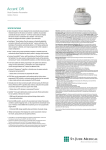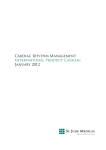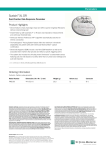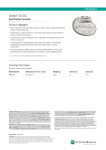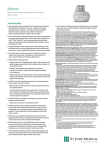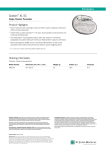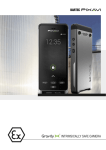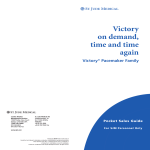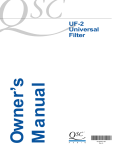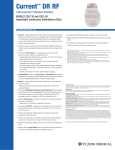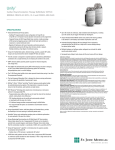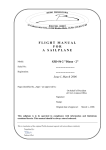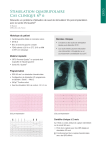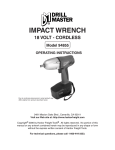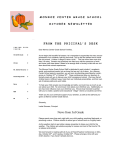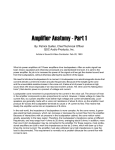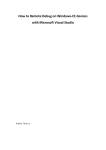Download Accent MRI™ DR - Sante International SA
Transcript
Pacemakers Accent MRI™ DR Dual-Chamber Pacemaker Product Highlights n The Accent MRI pacemaker has been designed and tested for safe performance of a full-body MRI scan, without zone restrictions,1 using a 1,5 T (Tesla) field-strength MRI scanner.1 The MRI conditional device: – Allows a maximum whole body averaged specific absorption rate (SAR) of 4 watts per kilogram (W/kg) for high image resolution – Must be used in conjunction with an MRI lead from St. Jude Medical n n n ™ An optional, easy-to-use hand-held device (SJM MRI Activator device) can be used to program the device to pre-approved MRI settings pre- and post-MRI scan, decreasing the number of workflow steps and increasing clinic efficiency AT/AF Alerts can be programmed to notify patients and/or their clinics when a programmed AT/AF threshold or continuous episode duration has been exceeded, or when a high ventricular rate accompanies the AT/AF episode A suite of state-of-the-art features—complete automaticity (atrial and ventricular), Ventricular Intrinsic Preference (VIP™) technology, QuickOpt™ timing cycle optimisation, the AF Suppression™ algorithm and SenseAbility ™ technology—is designed to deliver optimal therapy for patients at implant and throughout their lives Industry-leading longevity offers 9,4 years of service life,2 which is supported by a 7-year warranty 3 n 1. The St. Jude Medical™ MRI conditional pacing system can be scanned in patients under the following conditions: horizontal closed bore clinical scanner working in the Normal Operating Mode or First Level Controlled Operating Mode; static magnetic field strength of 1,5 Tesla (T) only; maximum gradient slew rate of 200 T/m/s per axis. See manual for additional details before performing an MRI scan. 2. A ,V = 2,5 V @ 0,4 ms; 500 ohms; 100% DDD pacing @ 60 bpm; AutoCapture™ Pacing System OFF; SEGMs ON 3. Terms and conditions apply; refer to the warranty for details. Ordering Information Contents: Cardiac pulse generator Model Number Dimensions (H x W x T, mm) Weight (g) Volume (cc) Connector PM2124 (Inductive) 52 x 53 x 6 23 13,1 (± 0,5) IS-1 Radiopaque markers St. Jude Medical identifier Indications: Implantation of a dual-chamber pulse generator is indicated in one or more of the following permanent conditions: syncope, presyncope, fatigue, disorientation due to arrhythmia/bradycardia or any combination of those symptoms. MRI conditional pulse generator is safe for use in the MRI environment when used in a complete MRI conditional pacing system and according to the instructions in the MRI Procedure Information document for the St. Jude Medical MRI conditional pacing system. Rate-modulated pacing is indicated for patients with chronotropic incompetence, and for those who would benefit from increased stimulation rates concurrent with physical activity. Dual-chamber pacing is indicated for those patients exhibiting: sick sinus syndrome, chronic, symptomatic second- and third-degree AV block, recurrent Adams-Stokes syndrome, symptomatic bilateral bundle branch block when tachyarrhythmia and other causes have been ruled out. Atrial pacing is indicated for patients with sinus node dysfunction and normal AV and intraventricular conduction systems. Ventricular pacing is indicated for patients with significant bradycardia and normal sinus rhythm with only rare episodes of A-V block or sinus arrest, chronic atrial fibrillation, severe physical disability. AF Suppression algorithm is indicated for suppression of paroxysmal or persistent atrial fibrillation episodes in patients with one or more of the above pacing indications. Contraindications: Dual-chamber pulse generators are contraindicated in patients with an implanted cardioverter defibrillator (ICD). Rate-adaptive pacing may be inappropriate for patients who experience angina or other symptoms of myocardial dysfunction at higher sensor-driven rates. An appropriate Maximum Sensor Rate should be selected based on assessment of the highest stimulation rate tolerated by the patient. AF Suppression stimulation is not recommended in patients who cannot tolerate high atrial-rate stimulation. Dual-chamber pacing, though not contraindicated for patients with chronic atrial flutter, chronic atrial Customer Support: 46-8-474-4756 Brief Summary: Prior to using these devices, please review the Instructions for Use for a complete listing of indications, contraindications, warnings, precautions, potential adverse events and directions for use. Devices depicted may not be available in all countries. Check with your St. Jude Medical representative for product availability in your country. Unless otherwise noted, ™ indicates that the name is a trademark of, or licensed to, St. Jude Medical or one of its subsidiaries. ST. JUDE MEDICAL, the nine-squares symbol and MORE CONTROL. LESS RISK. are registered and unregistered trademarks and service marks of St. Jude Medical, Inc. and its related companies. ©2011 St. Jude Medical, Inc. All rights reserved. Device MRI symbol fibrillation, or silent atria, may provide no benefit beyond that of single-chamber pacing in such patients. Single-chamber ventricular demand pacing is relatively contraindicated in patients who have demonstrated pacemaker syndrome, have retrograde VA conduction, or suffer a drop in arterial blood pressure with the onset of ventricular pacing. Single-chamber atrial pacing is relatively contraindicated in patients who have demonstrated compromise of AV conduction. Adverse Events: The following are potential complications associated with the use of any pacing system: arrhythmia, heart block, thrombosis, threshold elevation, valve damage, pneumothorax, myopotential sensing, vessel damage, air embolism, body rejection phenomena, cardiac tamponade or perforation, formation of fibrotic tissue, local tissue reaction, inability to interrogate or program a device because of programmer malfunction, infection, interruption of desired device function due to electrical interference, loss of desired pacing and/or sensing due to lead displacement, body reaction at electrode interface, or lead malfunction (fracture or damage to insulation), loss of normal device function due to battery failure or component malfunction, device migration, pocket erosion, or hematoma, pectoral muscle stimulation, and phrenic nerve or diaphragmatic stimulation. The following, in addition to the above, are potential complications associated with the use of rate-modulated pacing systems: inappropriate, rapid pacing rates due to sensor failure or to the detection of signals other than patient activity, loss of activity-response due to sensor failure, and palpitations with high-rate pacing. Refer to the User’s Manual for more detailed indications, contraindications, warnings, precautions and potential adverse events. Pacemakers Accent MRI™ DR Dual-Chamber Pacemaker Product Specifications PHYSICAL SPECIFICATIONS ModelPM2124 TelemetryInductive Dimensions (mm) 52 x 53 x 6 Weight (g) 23 Volume (cc) 13,11 Connector IS-1 PARAMETER SETTINGS Rate/Timing Atrial Pace Refractory (ms) Atrial Sense Refractory (ms) Atrial Protection Interval (ms) Paced AV Delay (ms) Base Rate (min-1) Far-Field Protection Interval (ms) Hysteresis Rate (min-1) Search Interval (min) Cycle Count Intervention Rate (min-1) Intervention Duration (min) Recovery Time Maximum Tracking Rate (min-1) Mode Post-Ventricular Atrial Blanking (ms) PVARP (ms) Sensed AV Delay (ms) Rest Rate (min-1) Shortest AV Delay (ms) Ventricular Blanking (ms) Ventricular Pace/Sense Refractory5 (Fixed) (ms) 190-400 in steps of 30; 440; 4702 93; 125; 157; 190-400 in steps of 30; 440; 470; 5002 1253 25; 30-200 in steps of 10; 225-300 in steps of 25; 350 30-130 in steps of 5; 140-170 in steps of 10 163 Off; 30 4-150 in steps of 5 Off; 1; 5; 10; 15; 30 1-16 in steps of 1 Off; Same as Base Rate; 80-120 in steps of 10; Intrinsic +0; Intrinsic +10; Intrinsic +20; Intrinsic +30 1-10 in 1-minute intervals Fast; Medium; Slow; Very Slow 90-130 in steps of 5; 140-180 in steps of 10 AOO(R); AAI(R); AAT(R); VOO(R); VVI(R); VVT(R); VDD(R); DOO(R); DVI(R); DDI(R); DDD(R); Pacing Off 60-200 in steps of 10; 225; 250 125-500 in steps of 25 25; 30-200 in steps of 10; 225-325 in steps of 25 Off; 30-150 in steps of 5 25-50 in steps of 5; 60-120 in steps of 10 Auto; 12-52 in steps of 4 125; 160-400 in steps of 30; 440; 4702 MRI Settings MRI Mode MRI Base Rate MRI Paced AV Delay MRI Atrial Pulse Configuration MRI Atrial Pulse Amplitude MRI Atrial Pulse Width MRI RV Pulse Configuration MRI RV Pulse Amplitude MRI RV Pulse Width AOO; VOO; DOO; Pacing Off 30-120 bpm in steps of 5 bpm 25 ms; 30-200 ms in steps of 10 ms; 225-300 ms in steps of 25 ms; 350 ms Bipolar 5,0 V; 7,5 V 1,0 ms Bipolar 5,0 V; 7,5 V 1,0 ms Output/Sensing ACap™ Confirm On; Off; Monitor Primary Pulse Configuration Bipolar Backup Pulse Configuration Bipolar Backup Pulse Amplitude (V) 5,0 Search Interval (hours) 8; 24 A or V Pulse Amplitude (V) 0,25-4,0 in steps of 0,25; 4,5-7,5 in steps of 0,5 A or V Pulse Width (ms) 0,05; 0,1-1,5 in steps of 0,1 A or V Pulse Configuration Unipolar (tip-case); Bipolar (tip-ring) A or V Sense Configuration Unipolar Tip (tip-case); Bipolar (tip-ring); Unipolar Ring (ring-case) Atrial Sensitivity (mV) 0,1-0,46 in steps of 0,1; 0,5; 0,75-2,0 in steps of 0,25; 2,5-4,0 in steps of 0,5; 5,07 ™ Ventricular AutoCapture Pacing System On; Off Primary Pulse Configuration Unipolar; Bipolar Backup Pulse Configuration Unipolar; Bipolar Backup Pulse Amplitude (V) 5,03 Search Interval (hours) 8; 24 AutoCapture Paced/Sensed AV Delay (ms) 50/25; 100/70; 120/100 Ventricular Sensitivity (mV) 0,5-5,0 in steps of 0,5; 6-10 in steps of 1,0; 12,57 ™ SenseAbility Technology Off; On (Automatic Sensitivity Control adjustment for atrial and ventricular events) A Max Sensitivity (mV) 0,2-1,0 in steps of 0,1 V Max Sensitivity (mV) 0,2-2,0 in steps of 0,1 Threshold Start (Atrial and Ventricular Post-Sense) 50; 62,5; 75; 100% (Atrial Post-Pace) 0,2-3,0 in steps of 0,1 mV (Ventricular Post-Pace) Auto; 0,2-3,0 in steps of 0,1 mV Decay Delay (ms) (Atrial and Ventricular Post-Sense) 0; 30; 60; 95; 125; 160; 190; 220 (Atrial Post-Pace) 0; 30; 60; 95; 125; 160; 190; 220 (Ventricular Post-Pace) Auto; 0; 30; 60; 95; 125; 160; 190; 220 (GMCRM739EN) Rate-Modulated Parameters Maximum Sensor Rate (min-1) Rate Responsive AV Delay Rate Responsive PVARP/VREF Reaction Time Recovery Time 80-150 in steps of 5; 160-180 in steps of 10 Off; Low; Medium; High Off; Low; Medium; High Very Fast; Fast; Medium; Slow Fast; Medium; Slow; Very Slow Customer Support: 46-8-474-4756 Brief Summary: Prior to using these devices, please review the Instructions for Use for a complete listing of indications, contraindications, warnings, precautions, potential adverse events and directions for use. Devices depicted may not be available in all countries. Check with your St. Jude Medical representative for product availability in your country. Unless otherwise noted, ™ indicates that the name is a trademark of, or licensed to, St. Jude Medical or one of its subsidiaries. ST. JUDE MEDICAL, the nine-squares symbol and MORE CONTROL. LESS RISK. are registered and unregistered trademarks and service marks of St. Jude Medical, Inc. and its related companies. ©2011 St. Jude Medical, Inc. All rights reserved. Item GMCRM739EN Sensor Shortest PVARP/VREF (ms) Slope Threshold AF Management On; Off; Passive 125-475 in steps of 25 Auto (-1); Auto (+0); Auto (+1); Auto (+2); Auto (+3); 1-16 in steps of 1 Auto (-0,5); Auto (+0,0); Auto (+0,5); Auto (+1,0); Auto (+1,5); Auto (+2,0); 1-7 in steps of 0,5 Off; On AF Suppression™ Algorithm 103 Lower Rate Overdrive (min-1) -1 Upper Rate Overdrive (min ) 53 No. of Overdrive Pacing Cycles 15-40 in steps of 5 Rate Recovery (ms) 8; 123 Maximum AF 80-150 in steps of 5; 160-180 in steps of 10 Suppression Rate (min-1) Atrial Tachycardia -1 110-200 in steps of 10; 225-300 in steps of 25 Detection Rate (min ) Auto Mode Switch Off; DDD(R) to DDI(R); DDD(R) to DDT(R); DDD(R) to VVI(R); DDD(R) to VVT(R); VDD(R) to VVI(R); VDD(R) to VVT(R) -1 40-170 in steps of 5 AMS Base Rate (min ) Stored Electrograms Options Priority Options Channel Triggers Advanced Hysteresis AMS Entry/AMS Exit/ AMS Entry and Exit AT/AF Detection Magnet Response High Atrial Rate Rate (min-1) No. of Consecutive Cycles High Ventricular Rate Rate (min-1) No. of Consecutive Cycles PMT Termination Consecutive PVCs No. of Consecutive PVCs Noise Reversion Off; Low; High 1; 2; 3 Off; Low; High Off; Low; High Off; Low; High Off; Low; High Off; Low; High 125-300 in steps of 25 2; 3; 4; 5; 10; 15; 20 Off; Low; High 125-300 in steps of 25 2; 3; 4; 5; 10; 15; 20 Off; Low; High Off; Low; High 2; 3; 4; 5 Off; Low; High Other A and V Lead Monitoring A and V Low Impedance Limit (Ω) A and V High Impedance Limit (Ω) Lead Type Magnet Response Negative AV Hysteresis Search (ms) NIPS Options Stimulation Chamber Coupling Interval (ms) S1 Count S19; S2; S3 and S4 Cycle (ms) Ventricular Support Rate (min-1) Sinus Node Recovery Delay (sec) PMT Options PMT Detection Rate (min-1) PVC Response Ventricular Intrinsic Preference, VIP™ (ms) VIP Search Interval VIP Search Cycles Ventricular Safety Standby Diagnostic Trends Monitor; Auto Polarity Switch 100-500 in steps of 25 750-2500 in steps of 250; 3000 Uncoded; Unipolar; Bipolar Off; Battery Test Off; -10 to -120 in steps of 10 Atrial; Ventricular 100-800 in steps of 108 2-25 in steps of 1 Off; 100-800 in steps of 10 (Fixed or Adaptive) Off; 30-95 in steps of 5 1; 2; 3; 4; 5 Off; Passive; Atrial Pace2 90-180 in steps of 5 Off; Atrial Pace2 Off; 50-150 in steps of 25; 160-200 in steps of 10 30 sec; 1; 3; 5; 10; 30 min 1; 2; 3 Off; On AT/AF Activity; Exercise; Lead Impedance; P and R Wave; A and V Threshold Patient Notifiers Programmable Notifiers (On; Off) Device at ERI; Atrial Lead Impedance Out of Range; Ventricular Lead Impedance Out of Range; AT/AF Burden; AT/AF Episode Duration; V Rate During AT/AF (High V Rate Threshold/ Total Time in High V Rate) Device Reset On Entry into Backup VVI Mode On Audible Duration (sec) 2; 4; 6; 8; 10; 12; 14; 16 Number of Audible Alerts per Notification 2 Number of Notifications 1-16 Time Between Notifications (hours) 10; 22 1. ± 0,5 cc 2. Programming options dependent on pacing mode. 3. This parameter is not programmable. 4. The highest available setting for hysteresis rate will be 5 min-1 below the programmed base rate. 5. In dual-chamber modes, the maximum ventricular refractory period is 325 ms. 6. Values 0,1-0,4 not available in a unipolar sense configuration. 7. Sensitivity is with respect to a 20 ms haversine test signal. 8. During atrial NIPS in dual-chamber modes, the shortest Coupling Interval will be limited by the programmed AV/PV delay. 9. S1 Burst Cycle is applied at the pre-programmed S1 cycle length. Pacemakers Accent MRI™ SR Single-Chamber Pacemaker Product Highlights n The Accent MRI pacemaker has been designed and tested for safe performance of a full-body MRI scan, without zone restrictions,1 using a 1,5 T (Tesla) field-strength MRI scanner.1 The MRI conditional device: – Allows a maximum whole body averaged specific absorption rate (SAR) of 4 watts per kilogram (W/kg) for high image resolution – Must be used in conjunction with an MRI lead from St. Jude Medical n n An optional, easy-to-use hand-held device (SJM MRI Activator device) can be used to program the device to pre-approved MRI settings pre- and post-MRI scan, decreasing the number of workflow steps and increasing clinic efficiency ™ State-of-the-art features—such as automaticity, Ventricular AutoCapture™ Pacing System and SenseAbility ™ technology—are designed to deliver optimal therapy for patients at implant and throughout their lives Industry-leading longevity offers 14,2 years of service life,2 which is supported by a 7-year warranty3 n 1. The St. Jude Medical™ MRI conditional pacing system can be scanned in patients under the following conditions: horizontal closed bore clinical scanner working in the Normal Operating Mode or First Level Controlled Operating Mode; static magnetic field strength of 1,5 Tesla (T) only; maximum gradient slew rate of 200 T/m/s per axis. See manual for additional details before performing an MRI scan. 2. V = 2,5 V @ 0,4 ms; 500 ohms; 100% VVI pacing @ 60 bpm; AutoCapture Pacing System OFF; SEGMs ON 3. Terms and conditions apply; refer to the warranty for details. Ordering Information Contents: Cardiac pulse generator Model Number Dimensions (H x W x T, mm) Weight (g) Volume (cc) Connector PM1124 (Inductive) 46 x 52 x 6 22 12 (± 0,5) IS-1 Radiopaque markers St. Jude Medical identifier Indications: Implantation of a single-chamber pulse generator is indicated in one or more of the following permanent conditions: syncope, presyncope, fatigue, disorientation due to arrhythmia/bradycardia or any combination of those symptoms. MRI conditional pulse generator is safe for use in the MRI environment when used in a complete MRI conditional pacing system and according to the instructions in the MRI Procedure Information document for the St. Jude Medical MRI conditional pacing system. Rate-modulated pacing is indicated for patients with chronotropic incompetence, and for those who would benefit from increased stimulation rates concurrent with physical activity. Atrial pacing is indicated for patients with sinus node dysfunction and normal AV and intraventricular conduction systems. Ventricular pacing is indicated for patients with significant bradycardia and normal sinus rhythm with only rare episodes of A-V block or sinus arrest, chronic atrial fibrillation, severe physical disability. Contraindications: Single-chamber pulse generators are contraindicated in patients with an implanted cardioverter defibrillator (ICD). Rate-adaptive pacing may be inappropriate for patients who experience angina or other symptoms of myocardial dysfunction at higher sensor-driven rates. An appropriate Maximum Sensor Rate should be selected based on assessment of the highest stimulation rate tolerated by the patient. Single-chamber ventricular demand pacing is relatively contraindicated in patients who have demonstrated pacemaker syndrome, have retrograde VA conduction, or suffer a drop in arterial blood pressure with the onset of ventricular pacing. Single-chamber atrial pacing is relatively contraindicated in patients who have demonstrated compromise of AV conduction. Customer Support: 46-8-474-4756 Brief Summary: Prior to using these devices, please review the Instructions for Use for a complete listing of indications, contraindications, warnings, precautions, potential adverse events and directions for use. Devices depicted may not be available in all countries. Check with your St. Jude Medical representative for product availability in your country. Unless otherwise noted, ™ indicates that the name is a trademark of, or licensed to, St. Jude Medical or one of its subsidiaries. ST. JUDE MEDICAL, the nine-squares symbol and MORE CONTROL. LESS RISK. are registered and unregistered trademarks and service marks of St. Jude Medical, Inc. and its related companies. ©2011 St. Jude Medical, Inc. All rights reserved. Device MRI symbol Adverse Events: The following are potential complications associated with the use of any pacing system: arrhythmia, heart block, thrombosis, threshold elevation, valve damage, pneumothorax, myopotential sensing, vessel damage, air embolism, body rejection phenomena, cardiac tamponade or perforation, formation of fibrotic tissue, local tissue reaction, inability to interrogate or program a device because of programmer malfunction, infection, interruption of desired device function due to electrical interference, loss of desired pacing and/or sensing due to lead displacement, body reaction at electrode interface, or lead malfunction (fracture or damage to insulation), loss of normal device function due to battery failure or component malfunction, device migration, pocket erosion, or hematoma, pectoral muscle stimulation, and phrenic nerve or diaphragmatic stimulation. The following, in addition to the above, are potential complications associated with the use of rate-modulated pacing systems: inappropriate, rapid pacing rates due to sensor failure or to the detection of signals other than patient activity, loss of activity-response due to sensor failure, and palpitations with high-rate pacing. Refer to the User’s Manual for more detailed indications, contraindications, warnings, precautions and potential adverse events. Pacemakers Accent MRI™ SR Single-Chamber Pacemaker Product Specifications PHYSICAL SPECIFICATIONS Stored Electrograms ModelPM1124 TelemetryInductive Dimensions (mm) 46 x 52 x 6 Weight (g) 22 Volume (cc) 121 Connector IS-1 Options Priority Options Channel Triggers Magnet Response High Ventricular Rate Rate (min-1) No. of Consecutive Cycles Advanced Hysteresis Noise Reversion PARAMETER SETTINGS Rate/Timing Ventricular Pace/Sense Refractory (Fixed) (ms) Base Rate (min-1) Mode Hysteresis Rate (min-1) Search Interval (min-1) Cycle Count Intervention Rate (min-1) Intervention Duration (min) Recovery Time Rest Rate (min-1) 125; 160-400 in steps of 30; 440; 470; 5002 30-130 in steps of 5; 140-170 in steps of 10 VOO(R); VVI(R); VVT(R); Pacing Off Off; 303-150 in steps of 5 Off; 1; 5; 10; 15; 30 1-16 by 1 Off; Same as Base Rate; 80-120 in steps of 10; Intrinsic +0; Intrinsic +10; Intrinsic +20; Intrinsic +30 1-10 in 1 minute intervals Fast; Medium; Slow; Very Slow Off; 30-150 in steps of 5 MRI Settings MRI Mode MRI Base Rate MRI RV Pulse Configuration MRI RV Pulse Amplitude MRI RV Pulse Width VOO; Pacing Off 30-120 bpm in steps of 5 bpm Bipolar 5,0 V; 7,5 V 1,0 ms Output/Sensing V Pulse Amplitude (V) V Pulse Width (ms) V Sensitivity (mV) V Pulse Configuration V Sense Configuration Ventricular AutoCapture™ Pacing System Primary Pulse Configuration Backup Pulse Configuration Backup Pulse Amplitude (V) Search Interval (hours) SenseAbility™ Technology Max Sensitivity (mV) Threshold Start Decay Delay (ms) 0,25-4,0 in steps of 0,25; 4,5-7,5 in steps of 0,5 0,05; 0,1-1,5 in steps of 0,1 0,5-5,0 in steps of 0,5; 6-10 in steps of 1,0; 12,5 4 Unipolar (tip-case); Bipolar (tip-ring) Unipolar Tip (tip-case); Bipolar (tip-ring); Unipolar Ring (ring-case) On; Off Unipolar; Bipolar Unipolar; Bipolar 5,05 8; 24 Off; On (Automatic Sensitivity Control adjustment for ventricular events) 0,2-2,0 in steps of 0,1 (Ventricular Post-Sense) 50; 62,5; 75; 100% (Ventricular Post-Pace) Auto; 0,2-3,0 in steps of 0,1 mV (Ventricular Post-Sense) 0; 30; 60; 95; 125; 160; 190; 220 (Ventricular Post-Pace) Auto; 0; 30; 60; 95; 125; 160; 190; 220 Rate-Modulated Parameters Maximum Sensor Rate (min-1) Rate Responsive VREF Shortest VREF Reaction Time Recovery Time Sensor Slope Threshold 80-150 in steps of 5; 160-180 in steps of 10 Off; Low; Medium; High 125-475 in steps of 25 Very Fast; Fast; Medium; Slow Fast; Medium; Slow; Very Slow On; Off; Passive Auto (-1); Auto (+0); Auto (+1); Auto (+2); Auto (+3); 1-16 in steps of 1 Auto (-0,5); Auto (+0,0); Auto (+0,5); Auto (+1,0); Auto (+1,5); Auto (+2,0); 1-7 in steps of 0,5 Customer Support: 46-8-474-4756 Brief Summary: Prior to using these devices, please review the Instructions for Use for a complete listing of indications, contraindications, warnings, precautions, potential adverse events and directions for use. Devices depicted may not be available in all countries. Check with your St. Jude Medical representative for product availability in your country. Unless otherwise noted, ™ indicates that the name is a trademark of, or licensed to, St. Jude Medical or one of its subsidiaries. ST. JUDE MEDICAL, the nine-squares symbol and MORE CONTROL. LESS RISK. are registered and unregistered trademarks and service marks of St. Jude Medical, Inc. and its related companies. ©2011 St. Jude Medical, Inc. All rights reserved. Item GMCRM740EN Off; Low; High 1; 2; 3 Off; Low; High Off; Low; High 125-300 in steps of 25 2; 3; 4; 5; 10; 15; 20 Off; Low; High Off; Low; High Other Lead Monitoring V Low Impedance Limit (Ω) V High Impedance Limit (Ω) Magnet Response Lead Type NIPS Options Stimulation Chamber Coupling Interval (ms) S1 Count S16 ; S2; S3 and S4 Cycle (ms) Diagnostic Trends Monitor; Auto Polarity Switch 100-500 in steps of 25 750-2500 in steps of 250; 3000 Off; Battery Test Uncoded; Unipolar; Bipolar Ventricular 100-800 in steps of 10 2-25 in steps of 1 100-800 in steps of 10 (Fixed or Adaptive) Exercise; Lead Impedance; R Wave; V Threshold Patient Notifiers Programmable Notifiers (On; Off) Device Reset Entry into Backup VVI Mode Audible Duration (sec) Number of Audible Alerts per Notification Number of Notifications Time Between Notifications (hours) Device at ERI; Ventricular Lead Impedance Out of Range On On 2; 4; 6; 8; 10; 12; 14; 16 2 1-16 10; 22 1. ± 0,5 cc 2. Programming options dependent on pacing mode. 3. The highest available setting for hysteresis rate will be 5 min-1 below the programmed base rate. 4. Sensitivity is with respect to a 20 ms haversine test signal. 5. This parameter is not programmable. 6. S1 Burst Cycle is applied at the preprogrammed S1 cycle length. Handheld MRI Pacemaker Settings Activator SJM MRI Activator™ Handheld Device Product Highlights n n The SJM MRI Activator™ handheld device, model EX4000, is an external device that uses radio waves to communicate with a St. Jude Medical MRI conditional implanted pulse generator The SJM MRI Activator device streamlines MRI patient workflow by allowing previously stored MRI settings to be easily: – Enabled before an MRI scan1 – Disabled after an MRI scan1 – Verified at any time Ordering Information Contents: SJM MRI Activator device Reorder Number Description EX4000 SJM MRI Activator EX4000 Intended Use: The SJM MRI Activator™ handheld device is used to evaluate the status of, and to enable and disable, the previously stored MRI settings. The activator is intended for use with St. Jude Medical™ MR Conditional pulse generators. Contraindications: There are no contraindications. Warnings and Precautions: Electromagnetic interference. The activator is not magnetic and has no moving parts. However, you should avoid equipment which generates a strong electromagnetic interference (EMI). EMI could interfere with communication between the activator and the implanted St. Jude Medical ™ MR conditional pulse generator. Moving away from the source of EMI or turning it off will usually allow the activator to return to its normal mode of operation. Communication equipment. Communication equipment such as microwave transmitters or high-power amateur transmitters may generate enough EMI to interfere Customer Support: 46-8-474-4756 Brief Summary: Prior to using these devices, please review the Instructions for Use for a complete listing of indications, contraindications, warnings, precautions, potential adverse events and directions for use. Devices depicted may not be available in all countries. Check with your St. Jude Medical representative for product availability in your country. Unless otherwise noted, ™ indicates that the name is a trademark of, or licensed to, St. Jude Medical or one of its subsidiaries. ST. JUDE MEDICAL, the nine-squares symbol and MORE CONTROL. LESS RISK. are registered and unregistered trademarks and service marks of St. Jude Medical, Inc. and its related companies. ©2011 St. Jude Medical, Inc. All rights reserved. with the performance of the activator if you are too close to the source of EMI. Wireless communication devices. Wireless communication devices such as computers that operate on a wireless network, handheld personal computers (PDA), cellular phones, and even cordless telephones may generate enough EMI to interfere with the performance of the activator if it is used too close to the source of EMI. Hospital and Medical equipment. A variety of standard hospital and medical equipment may generate enough EMI to interfere with the performance of the activator. These include, but are not limited to: blood pressure monitors, ECG equipment, external defibrillation equipment, x-ray machines. Office equipment. A variety of standard office equipment may generate enough EMI to interfere with the performance of the activator. These include, but are not limited to: desktop or laptop computers, fax machines, phone systems. Industrial equipment. A variety of industrial equipment may generate enough EMI to interfere with the performance of your activator. These include, but are not limited to: arc welders; induction furnaces; very large or defective electric motors; and internal combustion engines with poorly shielded ignition systems. Handheld MRI Pacemaker Settings Activator SJM MRI Activator™ Handheld Device Product Specifications PHYSICAL SPECIFICATIONS ModelEX4000 Dimensions (cm) 7,1 x 5,6 x 1,8 Case material High-impact plastic Power source 1 cell; 3,6 V (nominal); Chemistry: Lithium Thionyl Chloride Battery longevity 3 years from manufacturing date Audible output level 60 dB (minimum) at 10,0 cm Classification with respect to electric shock Internally powered Protection from electric shock (IEC 60601-1) Protection against ingress of liquids Mode of operation Type BF Ordinary equipment Non-continuous (GMCRM855EN) 1. T he SJM MRI Activator device is designed to enable/disable pre-programmed MRI mode quickly and easily pre- and post-scan; do not take the SJM MRI Activator device into the MRI magnet/scanner room. Customer Support: 46-8-474-4756 Brief Summary: Prior to using these devices, please review the Instructions for Use for a complete listing of indications, contraindications, warnings, precautions, potential adverse events and directions for use. Devices depicted may not be available in all countries. Check with your St. Jude Medical representative for product availability in your country. Unless otherwise noted, ™ indicates that the name is a trademark of, or licensed to, St. Jude Medical or one of its subsidiaries. ST. JUDE MEDICAL, the nine-squares symbol and MORE CONTROL. LESS RISK. are registered and unregistered trademarks and service marks of St. Jude Medical, Inc. and its related companies. ©2011 St. Jude Medical, Inc. All rights reserved. Item GMCRM855EN Pacing Leads Tendril MRI™ Pacing Lead Product Highlights n The Tendril MRI lead is designed to ensure patient safety while performing an MRI scan1 – The Tendril MRI conditional lead must be used in conjunction with an MRI device from St. Jude Medical and with a 1,5 T (Tesla) MRI scanner n Soft silicone tip offers more compliance at the lead tip-endocardium interface – The soft silicone tip on the Tendril MRI LPA1200M lead reduces tip pressure by approximately 50% over 6 F leads without a soft silicone tip2 Though the soft silicone increases the surface area of the lead tip to 9 F, the Tendril MRI lead still fits through an 8 F introducer due to the material’s soft nature. Four pads on the silicone tip further increase the surface area of the lead tip that is in contact with the tissue n n Optim™ lead insulation—a chemical co-polymer that blends the best features of polyurethane and silicone—provides improved handling and increased durability Limited lifetime warranty – Terms and conditions apply. Refer to the warranty for details 1. See manual for additional details before performing an MRI scan. 2. Bench testing data on file. Ordering Information Contents: Cardiac pacing lead Insulation Fixation Min. Introducer (F) Connector Length (cm) LPA1200M Optim Ext/Ret helix 8 IS-1 bipolar 46, 52 and 58 t Easily identifiable unique radiopaque markers t Model Number Indications: The Tendril MRI™ lead is designed for permanent sensing and pacing in either the right atrium or the right ventricle, in combination with a compatible device. Active leads such as the Tendril MRI lead may be indicated for patients where permanent fixation of passive leads is suspected to be unstable. In atrial applications, the use of a screw-in lead such as Tendril MRI lead may be indicated in the presence of an abnormal, surgically altered or excised atrial appendage. This is an MR Conditional lead. MR Conditional Pacing System: The St. Jude Medical MRI conditional lead is part of the St. Jude Medical™ MRI conditional pacing system. Patients with an implanted St. Jude Medical™ MRI conditional pacing system can have an MRI scan if the conditions for use, as described in the MRI Procedure Information document, are met. Customer Support: 46-8-474-4756 Brief Summary: Prior to using these devices, please review the Instructions for Use for a complete listing of indications, contraindications, warnings, precautions, potential adverse events and directions for use. Devices depicted may not be available in all countries. Check with your St. Jude Medical representative for product availability in your country. Unless otherwise noted, ™ indicates that the name is a trademark of, or licensed to, St. Jude Medical or one of its subsidiaries. ST. JUDE MEDICAL, the nine-squares symbol and MORE CONTROL. LESS RISK. are registered and unregistered trademarks and service marks of St. Jude Medical, Inc. and its related companies. ©2011 St. Jude Medical, Inc. All rights reserved. Contraindications: The Tendril MRI™ lead is contraindicated in the presence of tricuspid atresia, for patients with mechanical tricuspid valves, and in patients who are expected to be hypersensitive to a single dose of one milligram of dexamethasone sodium phosphate. Adverse Events: Potential complications associated with the use of Tendril MRI leads are the same as with the use of other active fixation leads and include: perforation of the myocardium, cardiac tamponade, phrenic nerve stimulation, dislodgement of the pacing lead, embolism, temporary or permanent loss of stimulation and/or sensing, infection, valve and/or vessel damage, tissue necrosis. Refer to the User’s Manual for more detailed indications, contraindications, warnings, precautions and potential adverse events. Pacing Leads Tendril MRI™ Pacing Lead Product Specifications PHYSICAL SPECIFICATIONS ModelLPA1200M Minimum Introducer Size 8F Minimum Introducer Size with Guidewire 10,5 F Type of Lead Active-fixation, steroid-eluting, endocardial, straight pacing lead Lead Connector IS-1 bipolar Lead Lengths 46, 52 and 58 cm Fixation Mechanism Extendable/Retractable helix Typical Number of Rotations for Helix Extension 5-10 (straight stylet) Lead Body Diameter 2,18 mm (max)/6,6 F Tip-to-Ring Spacing 10 mm Lead Tip Electrode (Cathode) Active TiN-coated Pt/Ir helix (1,8 mm extension) Tip Electrode Surface Area 6,8 mm2 Ring Electrode (Anode) TiN-coated Pt/Ir Ring Electrode Surface Area 16,5 mm2 Mapping Capable with TiN-coated Pt/Ir helix Steroid Silicone plug with <1 mg dexamethasone sodium phosphate Inner Conductor/Outer Conductor MP35N™* coil Inner Insulation Silicone Outer Insulation Optim™ lead insulation In Pack Straight stylets J-shaped stylets Helix extension/retraction clip-on tools Accessory Kits Available Separately Model Number 1 x-soft in lead, 1 x-soft, 1 soft 2 soft 2 clip-on tools Compatible Lengths Description Stylet Kit DSO6002 with appropriate 46, 52 and 58 cm 1 fixation tool, 1 clip-on tool, length designation 1 J-shaped soft, 1 x-soft, 1 soft, 1 firm, 1 x-firm DSO6003 with appropriate 46, 52 and 58 cm 1 clip-on tool, 1 J-shaped soft, length designation 1 x-soft, 1 soft, 1 firm, 1 x-firm 1281 with appropriate 46, 52 and 58 cm Disposable implant tool to Locator™ Plus Deflectable Stylet length designation facilitate precise lead positioning 1292 with appropriate 46, 52 and 58 cm and manipulation with one hand length designation (GMCRM741EN) *MP35N is a trademark of SPS Technologies, Inc. Customer Support: 46-8-474-4756 Brief Summary: Prior to using these devices, please review the Instructions for Use for a complete listing of indications, contraindications, warnings, precautions, potential adverse events and directions for use. Devices depicted may not be available in all countries. Check with your St. Jude Medical representative for product availability in your country. Unless otherwise noted, ™ indicates that the name is a trademark of, or licensed to, St. Jude Medical or one of its subsidiaries. ST. JUDE MEDICAL, the nine-squares symbol and MORE CONTROL. LESS RISK. are registered and unregistered trademarks and service marks of St. Jude Medical, Inc. and its related companies. ©2011 St. Jude Medical, Inc. All rights reserved. Item GMCRM741EN








